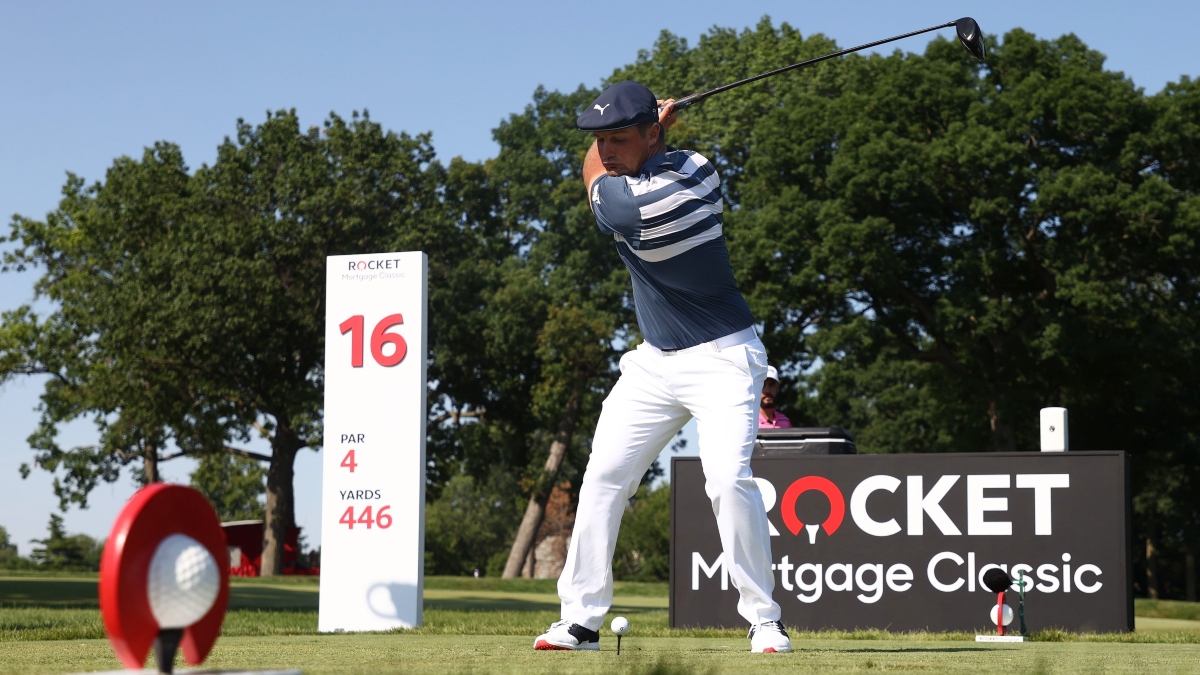The Bryson Dilemma: How To Fix Golf’s Distance Problem (Without Changing the Ball)
Gregory Shamus/Getty Images. Pictured: Bryson DeChambeau
The modern golf ball goes too far.
That's what all of the experts say. One of them opined, "They certainly make the courses easier." Another has suggested, "It will ruin the game." Yet another thinks, "It should be regulated." And then there’s a Rules of Golf committee member who goes so far as to say, "The ball is evil to the game."
If you find yourself nodding your head in agreement with these implications — with Bryson DeChambeau serving as Exhibit A for how a player can train his body, increase his swing speed and use contemporary analytics to send the golf ball soaring previously-undiscovered distances — well, I’ve got some news for you.
Those comments are from an article in Golf Illustrated. It was published in 1902.
To suggest that outrage over the distance debate in golf is an open-ended argument is still a massive understatement. This has lingered as a topic of conversation for so long that the discussion predates Ben Hogan’s birth by a decade.
It’s entirely conceivable that those in today’s society who are screaming at each other on social media in regard to this issue are simply echoing the front-stoop disputes of their great-grandparents.
That doesn’t mean, of course, that the current debates are without merit.
Just last week, none other than Jack Nicklaus rekindled his passionate plea, telling a national TV audience: "The golf ball is a very simple thing to fix and I've been preaching about it for 43 years. I mean, that's a long time to be studying something. Guys, stop studying it and do something, will you please?"
Here’s the diluted version of this side of the fence: Hitting the ball increased distances off the tee not only negates the shot-making abilities on which the game was founded, it's causing some of our most treasured courses to become obsolete. Take Augusta National, which was once "Tiger-proofed" by an addition of 500 yards, but the reality is that it only helped the longest hitter instead.
Rolling back the golf ball, limiting current distances by 10% or 15% — or even 20% — is the most appropriate way, the experts contend, of neutralizing this advantage and preserving the game to its natural roots.
It might be an age-old argument, but is it an illogical one? After more than a century of railing against the components of the "modern" ball, after 43 years of the game's most famous golfer stating his case, is it fruitless to believe there is a voice which will finally facilitate change?
In other words: Should we start trying to combat the distance surge with alternate ideas that haven't been broached for so long?
I believe so.
Whether these are short- or long-term solutions, there are outside-the-box hypotheses that can help limit the influence of length on the leaderboards every week. None will have as direct of an impact as limiting the ball, but after so many years of knocking on the same door, maybe it’s time we collectively tried another entrance. Let's run through four alternatives.
1. Limit the Maximum Number of Clubs
At some point, it was decided in the Rules of Golf that the precise amount of clubs in one’s golf bag should be 14. Why?
Well, that's a great question, and there certainly isn’t an answer that would preclude this rule from being changed. There is no reason golfers can't be limited to 12 or 10 or even eight clubs. We don't even need bifurcation to implement this rule, as it would make all of us — pros and amateurs alike — focus just a little bit more on decision-making and strategy.
This is how the idea indirectly impacts the distance debate: Without such thin margins with so many clubs, golfers would have to rethink tee shots, since the bomb-and-gouge approach could result in being in positions for which there is no perfect club.
2. Adjust the Tee Boxes
No, I don't mean we should keep moving 'em back, stretching out courses to the narrowest confines in order to counterattack increased distance. I mean, literally, adjusting the size and shape and angle of such teeing grounds.
We’ve all done it: Stood on a par-4, grab driver, banged it dead-straight and watched it trickle into the trees in the right rough, only to then realize that the angle of the tee box had us aiming in the wrong direction. As golfers, we hate this deception, but it’s a clever ploy by those who design courses to keep us on our collective toes.
It’s all about making players uncomfortable, which is an intelligent way to retaliate against length off the tee.
Look, I’m not naïve enough to believe that shortening the width of a tee box and changing the angle would be enough to keep a guy like DeChambeau from belting his drives 380 yards, but little adjustments like this could help to place more of a premium on accuracy and offer more of a punishment to wayward blows.
3. Create More Par-3.5 and 4.5 Holes
What is par? That’s an existential question — the golfer’s equivalent to, "Why are we here?" and "What is our purpose?"
The main reason for having par on a hole is simply for a colloquial delineation of individual scores. Without par, there are no birdies and no bogeys, just numbers on a scorecard. And yet, par doesn’t have to be a whole number without decimal points, really.
No, I’m not calling for actual par-3.5 holes on courses — mostly because I can’t stand the idea of making half-bogeys. What I would like to see, however, is more holes that really can’t be pigeon-holed to a specific number.
For all of the organization's faults, the USGA has done a brilliant job setting up holes like this at the U.S. Open over the years. While it wouldn't directly curtail driving distance, it would be yet another way to make players feel more uncomfortable, which in turn could lead to a less-advantageous strategy of simply bombing driver everywhere.
4. Inconsistent Green Speeds
OK, I’ll admit this one isn’t directly in relation to the ball going too far, but it is part of the same domino effect: Essentially, players are hitting the ball so far that it leads to more birdie opportunities, which leads to better scoring, which leads to the game being perceived as too easy.
I will also admit that I’m expecting some mean tweets from pros and amateurs alike who will abhor this idea, but everyone will concede that it would curb such low scoring.
Basically the idea is that, instead of consistent green speeds throughout the golf course, each green can be cut to its own personal number. One might be running 11 on the StimpMeter, the next 9 and the one after that 13. The objective would be to confound players, again making them feel more uncomfortable and forcing them to employ more strategy into how they will attack each hole.
How would you rate this article?






